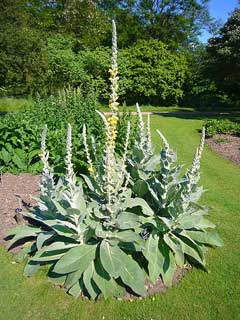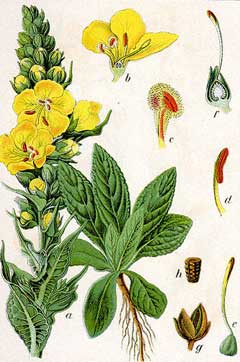 |
|
commons.wikimedia.org/wiki/User:Magnus_Manske |
 |
| commons.wikimedia.org/wiki/File:Verbascum_densiflorum_Sturm18.jpg |
Translate this page:
Summary
Physical Characteristics

 Verbascum densiflorum is a BIENNIAL growing to 1.2 m (4ft) by 0.6 m (2ft in).
Verbascum densiflorum is a BIENNIAL growing to 1.2 m (4ft) by 0.6 m (2ft in).
See above for USDA hardiness. It is hardy to UK zone 5. It is in flower from July to August. The species is hermaphrodite (has both male and female organs) and is pollinated by Insects. The plant is self-fertile.
Suitable for: light (sandy), medium (loamy) and heavy (clay) soils and prefers well-drained soil. Suitable pH: mildly acid, neutral and basic (mildly alkaline) soils and can grow in very alkaline soils.
It cannot grow in the shade. It prefers dry or moist soil.
UK Hardiness Map
US Hardiness Map
Synonyms
V. thapsiforme. Schrader.
Plant Habitats
Cultivated Beds;
Edible Uses
References More on Edible Uses
Medicinal Uses
Plants For A Future can not take any responsibility for any adverse effects from the use of plants. Always seek advice from a professional before using a plant medicinally.
Anodyne Antirheumatic Antiseptic Astringent Demulcent Diuretic Emollient Expectorant
Pectoral Vulnerary
The flowers and leaves are anodyne, antiseptic, astringent, demulcent, emollient, expectorant and vulnerary[4, 9, 13, 21, 46, 53, 165, 238]. An infusion is used internally in the treatment of various respiratory complaints including coughs, bronchitis, asthma and throat irritations[9, 238]. An infusion of the fresh or dried flowers in olive oil is used to treat earaches, sores, wounds, boils etc[238]. The plant is harvested when in flower and should be dried quickly and with care or it will lose its medicinal qualities[9, 238].
References More on Medicinal Uses
The Bookshop: Edible Plant Books
Our Latest books on Perennial Plants For Food Forests and Permaculture Gardens in paperback or digital formats.

Edible Tropical Plants
Food Forest Plants for Hotter Conditions: 250+ Plants For Tropical Food Forests & Permaculture Gardens.
More

Edible Temperate Plants
Plants for Your Food Forest: 500 Plants for Temperate Food Forests & Permaculture Gardens.
More

More Books
PFAF have eight books available in paperback and digital formats. Browse the shop for more information.
Shop Now
Other Uses
References More on Other Uses
Cultivation details
Succeeds in most well-drained soils, including dry ones, preferring a sunny position[200]. Dislikes shade and wet soils[200]. Thrives on chalk[200]. Prefers a light soil[200]. Plants are hardy to about -20°c[187]. This species is closely related to V. phlomoides[200]. Hybridizes with other members of this genus, though the progeny are usually sterile[200].
References Carbon Farming Information and Carbon Sequestration Information
Temperature Converter
Type a value in the Celsius field to convert the value to Fahrenheit:
Fahrenheit:
The PFAF Bookshop
Plants For A Future have a number of books available in paperback and digital form. Book titles include Edible Plants, Edible Perennials, Edible Trees,Edible Shrubs, Woodland Gardening, and Temperate Food Forest Plants. Our new book is Food Forest Plants For Hotter Conditions (Tropical and Sub-Tropical).
Shop Now
Plant Propagation
Seed - sow late spring to early summer in a cold frame and only just cover the seed[200]. Germination usually takes place within 2 - 3 weeks. When they are large enough to handle, prick out the seedlings into individual pots and plant them out in late summer. The seed has a long viability[200].
Other Names
If available other names are mentioned here
Native Range
TEMPERATE ASIA: Turkey, Azerbaijan, Georgia EUROPE: Denmark, Sweden, Austria, Belgium, Switzerland, Czech Republic, Germany, Hungary, Netherlands, Poland, Slovakia, Russian Federation (European part), Estonia, Moldova, Ukraine (incl. Krym), Albania, Bulgaria, Greece, Croatia, Italy, Romania, Serbia, Slovenia, Spain, France, Portugal AFRICA: Morocco
Weed Potential
Right plant wrong place. We are currently updating this section.
Please note that a plant may be invasive in one area but may not in your area so it's worth checking.
Conservation Status
IUCN Red List of Threatened Plants Status :

| Related Plants
|
| Latin Name | Common Name | Habit | Height | Hardiness | Growth | Soil | Shade | Moisture | Edible | Medicinal | Other |
| Verbascum blattaria | Moth Mullein | Biennial/Perennial | 1.0 |
5-9
| | LMH | N | DM | 0 | 0 | 2 |
| Verbascum lychnitis | White Mullein | Biennial | 1.0 |
5-9
| | LMH | N | DM | 0 | 0 | 2 |
| Verbascum nigrum | Dark Mullein, Black mullein | Biennial/Perennial | 1.0 |
4-8
| | LMH | N | DM | 0 | 3 | 2 |
| Verbascum phlomoides | Wooly Mullein, Orange mullein | Biennial/Perennial | 1.2 |
5-9
| | LMH | N | DM | 0 | 3 | 2 |
| Verbascum pulverulentum | Hoary Mullein, Broad-leaf mullein | Biennial | 1.8 |
3-7
| | LMH | N | DM | 0 | 1 | 2 |
| Verbascum thapsus | Great Mullein, Common mullein, Aaron's Rod, Flannel Plant, Hag Taper, Mullein, Torches, Velvet Plant | Biennial | 1.8 |
3-8
| F | LMH | N | DM | 1 | 3 | 4 |
|
Growth: S = slow M = medium F = fast. Soil: L = light (sandy) M = medium H = heavy (clay). pH: A = acid N = neutral B = basic (alkaline). Shade: F = full shade S = semi-shade N = no shade. Moisture: D = dry M = Moist We = wet Wa = water.
Now available:
Food Forest Plants for Mediterranean Conditions
350+ Perennial Plants For Mediterranean and Drier Food Forests and Permaculture Gardens.
[Paperback and eBook]
This is the third in Plants For A Future's series of plant guides for food forests tailored to
specific climate zones. Following volumes on temperate and tropical ecosystems, this book focuses
on species suited to Mediterranean conditions—regions with hot, dry summers and cool, wet winters,
often facing the added challenge of climate change.
Read More
Expert comment
Author
Bertol.
Botanical References
200
Links / References
For a list of references used on this page please go here
Readers comment